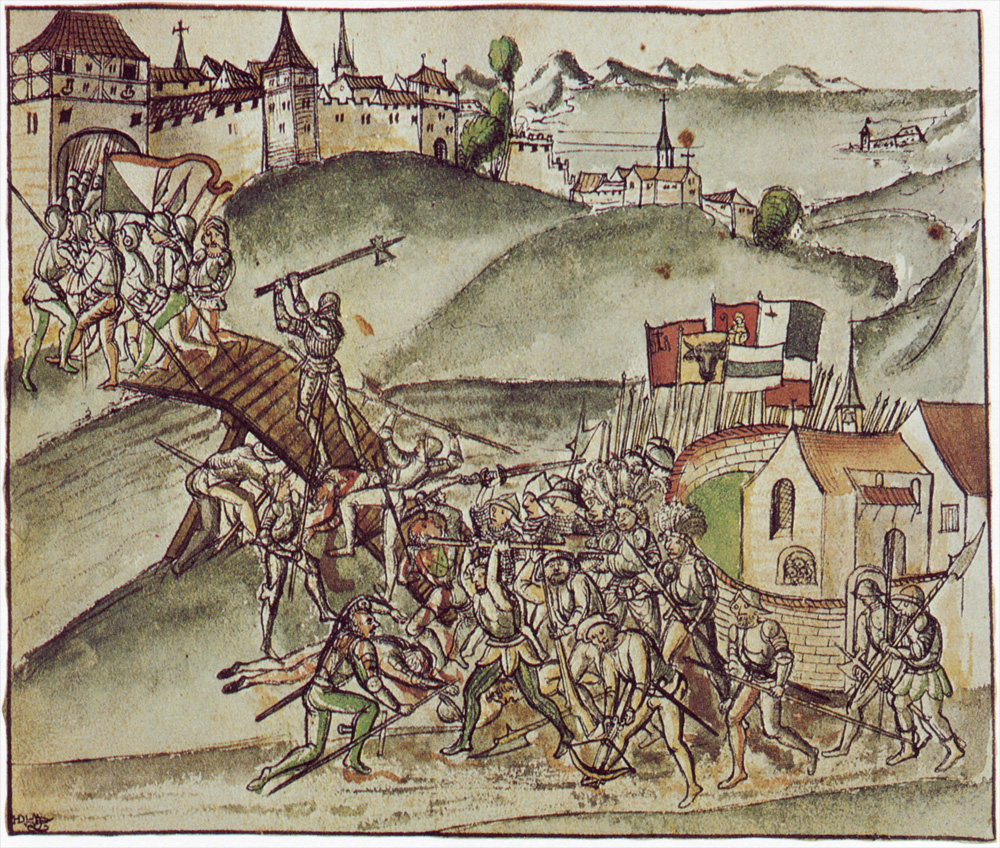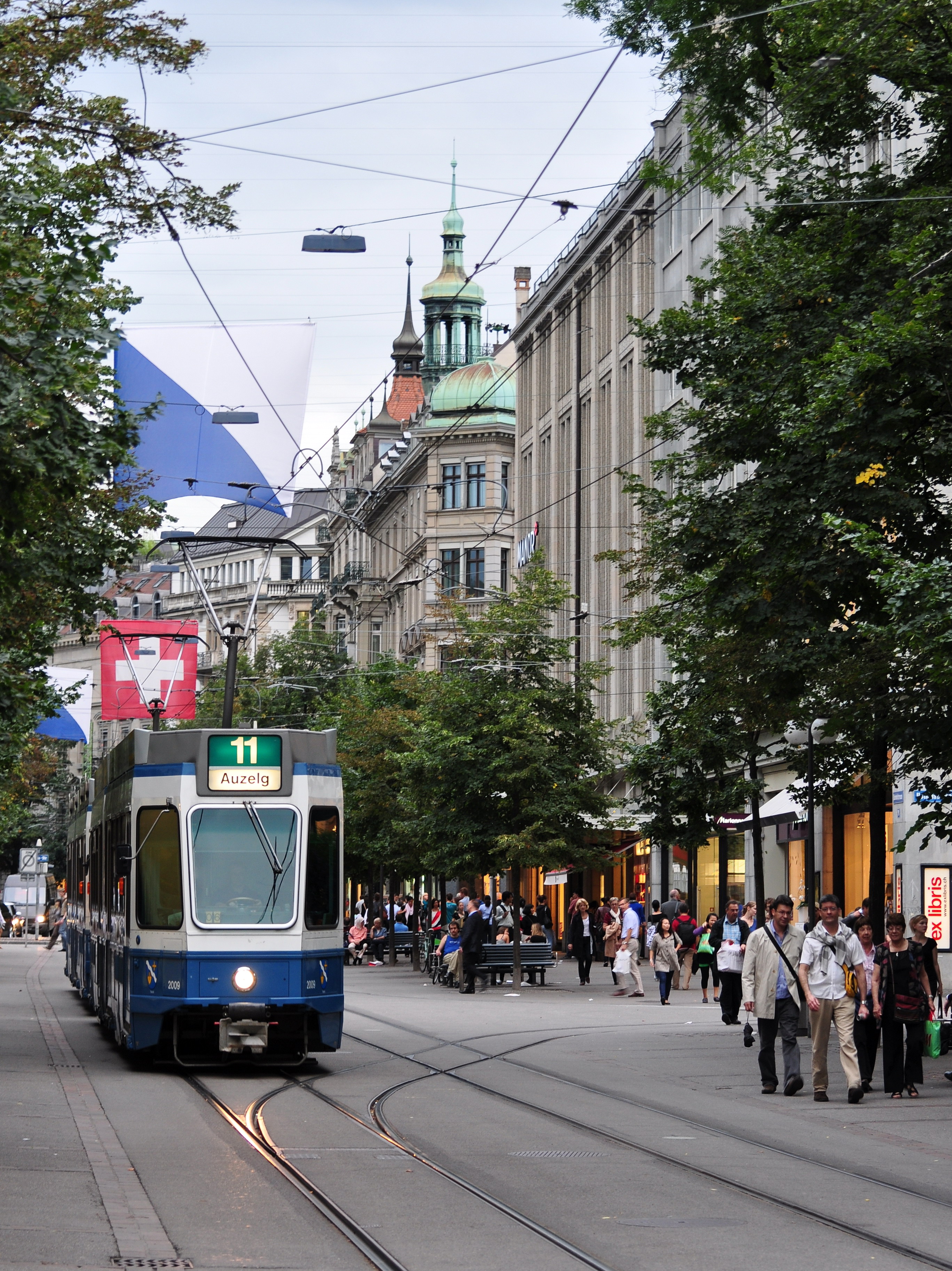|
Rennweg (Zürich)
''Rennweg'' is a medieval main road and is today part of the inner-city pedestrian zone of Zürich, Switzerland. A ''rennweg'' was in the medieval German speaking territories a street where horses were moved.Schweizerisches Idiotikon, vol. VI, col. 840 f., articl''Ränn-Wëg'' and vol. VI, col. 961 sqq., articl''rännen'' esp. meanings 1d («ein Pferd in eilige Bewegung setzen, hetzen») and 2a («mit verhängtem Zügel, in schärfster Gangart reiten, fahren»). Once, it was one of the nodal points of road and public transportation. Today, as well as the Limmatquai, as well as Augustinergasse, it is a section of the southern extension of the '' Seeuferanlage'' promenades that were built between 1881 and 1887. ''Rennweg'' is one of the best known visitor attractions of the oldest area of the city of Zürich. Geography and history Archaeologists excavated individual and aerial finds of the Celtic-Helvetii oppidum Lindenhof from around the 1st century BC La Tène culture ... [...More Info...] [...Related Items...] OR: [Wikipedia] [Google] [Baidu] |
Limmatquai
''Limmatquai'' is a street in the Swiss city of Zürich. It is named after the Limmat, and it follows the right-hand (eastern) bank of that river for about through the ''Altstadt'', or historical core, of the city. The street was once important for both road and public transportation, but today sections of it form a pedestrian zone shared with Zürich's trams, effectively forming a northern extension of the '' Seeuferanlage'' promenades that ring the shores of Lake Zürich. The ''Limmatquai'' has its southern end adjacent to the '' Quaibrücke'' bridge and ''Bellevueplatz'' square, where the Limmat flows out of Lake Zürich. Its northern end is at the '' Bahnhofbrücke'' bridge and '' Central'' plaza. Between the ''Quaibrücke'' and the ''Bahnhofbrücke'', the river is crossed by four other bridges all of which connect to the ''Limmatquai''; from south to north these are the '' Münsterbrücke'', '' Rathausbrücke'', '' Rudolf-Brun-Brücke'' and '' Mühlesteg''. For most of its ... [...More Info...] [...Related Items...] OR: [Wikipedia] [Google] [Baidu] |
Grün Stadt Zürich
Grün Stadt Zürich, commonly shortened to GSZ, is the ''Office of Parks and Open Spaces'' being a service of the Civil Engineering and Waste Management Department of Swiss city of Zürich. Gsz is responsible for creating, preserving and maintaining the city's park system, sports facilities, urban forests, cemeteries, public swimming pools and playgrounds. Ten farms, nine of which are leased out, several nature schools, the local plant nursery, the Succulent Plant Collection and the Chinagarten are also operated, as well as the Quaianlagen promenades at the Zürichsee lake shore. Scope of activities The department includes five divisions: Operations, Services, Promotion of Nature, Planning/Construction and Maintenance. Operations The Operations Division includes the nine municipal farms which are leased out and the agricultural estate "Juchhof". The "Juchhof" meets the requirements of the Swiss Ecologic Performance Record (ökologischer Leistungsnachweis ÖLN). The city ... [...More Info...] [...Related Items...] OR: [Wikipedia] [Google] [Baidu] |
July 22
Events Pre-1600 * 838 – Battle of Anzen: The Byzantine emperor Theophilos suffers a heavy defeat by the Abbasids. *1099 – First Crusade: Godfrey of Bouillon is elected the first Defender of the Holy Sepulchre of The Kingdom of Jerusalem. *1209 – Massacre at Béziers: The first major military action of the Albigensian Crusade. *1298 – Wars of Scottish Independence: Battle of Falkirk: King Edward I of England and his longbowmen defeat William Wallace and his Scottish schiltrons outside the town of Falkirk. *1342 – St. Mary Magdalene's flood is the worst such event on record for central Europe. *1443 – Battle of St. Jakob an der Sihl in the Old Zürich War. *1456 – Ottoman wars in Europe: Siege of Belgrade: John Hunyadi, Regent of the Kingdom of Hungary, defeats Mehmet II of the Ottoman Empire. *1484 – Battle of Lochmaben Fair: A 500-man raiding party led by Alexander Stewart, Duke of Albany and James Douglas, 9th Earl of ... [...More Info...] [...Related Items...] OR: [Wikipedia] [Google] [Baidu] |
Old Zürich War
The Old Zurich War (german: Alter Zürichkrieg), 1440–46, was a conflict between the canton of Zurich and the other seven cantons of the Old Swiss Confederacy over the succession to the Count of Toggenburg. In 1436, Count Friedrich VII of Toggenburg died, leaving neither heir nor will. The canton of Zurich, led by burgomaster Rudolf Stüssi, claimed the Toggenburg lands; the cantons of Schwyz and Glarus made counter-claims, backed by the other cantons. In 1438 Zurich occupied the disputed area and cut off grain supplies to Schwyz and Glarus. In 1440, the other cantons expelled Zurich from the confederation and declared war. Zurich retaliated by making an alliance with Frederick III, Holy Roman Emperor of the house of Habsburg. The forces of Zurich were defeated in the Battle of St. Jakob an der Sihl on 22 July 1443 and Zurich was besieged. Frederick appealed to Charles VII of France to attack the confederates and the latter sent a force of about 30,000 Armagnac merce ... [...More Info...] [...Related Items...] OR: [Wikipedia] [Google] [Baidu] |
Battle Of St
A battle is an occurrence of combat in warfare between opposing military units of any number or size. A war usually consists of multiple battles. In general, a battle is a military engagement that is well defined in duration, area, and force commitment. An engagement with only limited commitment between the forces and without decisive results is sometimes called a skirmish. The word "battle" can also be used infrequently to refer to an entire operational campaign, although this usage greatly diverges from its conventional or customary meaning. Generally, the word "battle" is used for such campaigns if referring to a protracted combat encounter in which either one or both of the combatants had the same methods, resources, and strategic objectives throughout the encounter. Some prominent examples of this would be the Battle of the Atlantic, Battle of Britain, and Battle of Stalingrad, all in World War II. Wars and military campaigns are guided by military strategy, wher ... [...More Info...] [...Related Items...] OR: [Wikipedia] [Google] [Baidu] |
Bahnhofstrasse
Bahnhofstrasse is Zürich's main downtown street and one of the world's most expensive and exclusive shopping avenues. In 2011, a study named the ''Bahnhofstrasse'' the most expensive street for retail property in Europe, and the third most expensive worldwide. In 2016, the street ranked ninth. It came into existence when the city fortifications were demolished in 1864 and the ditch in front of the walls was filled in. Until that time, the name of the location had been ''Fröschengraben'' ("Ditch Of The Frogs"), which then was changed to ''Bahnhofstrasse'' ("Railway Station Street"). Bahnhofstrasse starts at ''Bahnhofplatz'' ("Station Square") in front of the Zürich Hauptbahnhof (), passing '' Rennweg, Augustinergasse'' and '' Paradeplatz'' before it ends after 1.4 km at '' Bürkliplatz'' () on Lake Zürich ( National Bank), (Hotel Baur au Lac). The street is largely pedestrianised, but is also an important link in the Zürich tram network. North of ''Paradeplatz'' t ... [...More Info...] [...Related Items...] OR: [Wikipedia] [Google] [Baidu] |
Zürich Town Hall
, neighboring_municipalities = Adliswil, Dübendorf, Fällanden, Kilchberg, Maur, Oberengstringen, Opfikon, Regensdorf, Rümlang, Schlieren, Stallikon, Uitikon, Urdorf, Wallisellen, Zollikon , twintowns = Kunming, San Francisco Zürich () is the largest city in Switzerland and the capital of the canton of Zürich. It is located in north-central Switzerland, at the northwestern tip of Lake Zürich. As of January 2020, the municipality has 434,335 inhabitants, the urban area 1.315 million (2009), and the Zürich metropolitan area 1.83 million (2011). Zürich is a hub for railways, roads, and air traffic. Both Zurich Airport and Zürich's main railway station are the largest and busiest in the country. Permanently settled for over 2,000 years, Zürich was founded by the Romans, who called it '. However, early settlements have been found dating back more than 6,400 years (although this only indicates human presence in the area and not the presence of a town that early ... [...More Info...] [...Related Items...] OR: [Wikipedia] [Google] [Baidu] |
Lindenhof Hill
The Lindenhof (lit.: ''courtyard of the lime'') is a moraine hill and a public square in the historic center of Zürich, Switzerland. It is the site of the Roman and Carolingian era Kaiserpfalz around which the city has historically grown. The hilltop area—including its prehistoric, Roman, and medieval remains—is listed as a Swiss heritage site of national significance. Topography Lindenhof (its northern part is called ''Sihlbühl'') dominates the Lindenhof quarter in district 1 (Altstadt), the historical center of Zürich's Altstadt. To the North, it ends at ''Uraniastrasse'' (City police station) and to the South, it ends near St. Peter church. In the West, the hill is limited by the Bahnhofstrasse, and in the east, it ends at the Limmat and the Schipfe quarter. Lindenhof sits atop the remains of a glacier. The hill and its public square are part of the Linth Glacier's moraines in the area of Zürich. The now largely flattened Lindenhof (428 m ü. M) rises about 25 met ... [...More Info...] [...Related Items...] OR: [Wikipedia] [Google] [Baidu] |
Fortifications Of Zürich
Zürich was an independent (''reichsfrei'') city or city-state from 1218 to 1798. The town was fortified with a city wall from the 13th to the 17th century, and with more elaborate ramparts constructed in the 17th to 18th century and mostly demolished in the 1830s to 1870s. First wall There had been a first city wall dating to the 11th or 12th century. The existence of such an early wall had been suggested, but the mainstream view assumed that the town had been unfortified – the remains of the Roman castle at the Vicus ''Turicum'', and a so-called Kaiserpfalz on Lindenhof hill excepted – before the 13th century, until the chance discovery of remnants of the first wall during the 1990s construction work at the central library respectively location of the Predigerkloster, the former Dominican abbey. Second wall Following the extinction of the main line of the Zähringer family in 1218, Zürich became a free imperial city. Over the following decades, a city wall was construct ... [...More Info...] [...Related Items...] OR: [Wikipedia] [Google] [Baidu] |
La Tène Culture
The La Tène culture (; ) was a European Iron Age culture. It developed and flourished during the late Iron Age (from about 450 BC to the Roman conquest in the 1st century BC), succeeding the early Iron Age Hallstatt culture without any definite cultural break, under considerable Mediterranean influence from the Greeks in pre-Roman Gaul, the Etruscans, and the Golasecca culture, but whose artistic style nevertheless did not depend on those Mediterranean influences. La Tène culture's territorial extent corresponded to what is now France, Belgium, Switzerland, Austria, England, Southern Germany, the Czech Republic, parts of Northern Italy and Central Italy, Slovenia and Hungary, as well as adjacent parts of the Netherlands, Slovakia, Serbia, Croatia, Transylvania (western Romania), and Transcarpathia (western Ukraine). The Celtiberians of western Iberia shared many aspects of the culture, though not generally the artistic style. To the north extended the contemporary P ... [...More Info...] [...Related Items...] OR: [Wikipedia] [Google] [Baidu] |






